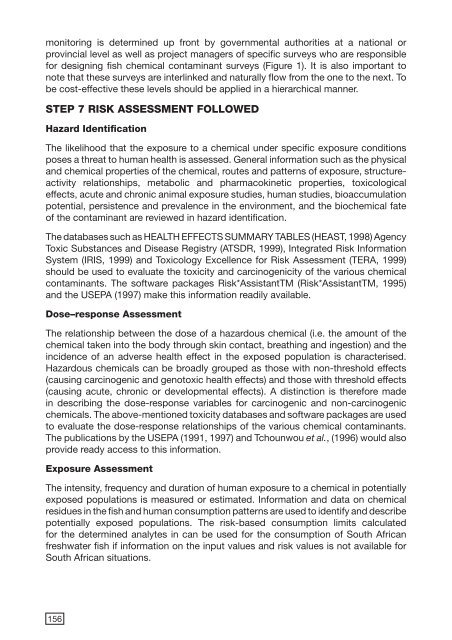Download as a PDF - CiteSeerX
Download as a PDF - CiteSeerX
Download as a PDF - CiteSeerX
Create successful ePaper yourself
Turn your PDF publications into a flip-book with our unique Google optimized e-Paper software.
monitoring is determined up front by governmental authorities at a national or<br />
provincial level <strong>as</strong> well <strong>as</strong> project managers of specific surveys who are responsible<br />
for designing fish chemical contaminant surveys (Figure 1). It is also important to<br />
note that these surveys are interlinked and naturally flow from the one to the next. To<br />
be cost-effective these levels should be applied in a hierarchical manner.<br />
STEP 7 RISK ASSESSMENT FOLLOWED<br />
Hazard Identification<br />
The likelihood that the exposure to a chemical under specific exposure conditions<br />
poses a threat to human health is <strong>as</strong>sessed. General information such <strong>as</strong> the physical<br />
and chemical properties of the chemical, routes and patterns of exposure, structureactivity<br />
relationships, metabolic and pharmacokinetic properties, toxicological<br />
effects, acute and chronic animal exposure studies, human studies, bioaccumulation<br />
potential, persistence and prevalence in the environment, and the biochemical fate<br />
of the contaminant are reviewed in hazard identification.<br />
The datab<strong>as</strong>es such <strong>as</strong> HEALTH EFFECTS SUMMARY TABLES (HEAST, 1998) Agency<br />
Toxic Substances and Dise<strong>as</strong>e Registry (ATSDR, 1999), Integrated Risk Information<br />
System (IRIS, 1999) and Toxicology Excellence for Risk Assessment (TERA, 1999)<br />
should be used to evaluate the toxicity and carcinogenicity of the various chemical<br />
contaminants. The software packages Risk*AssistantTM (Risk*AssistantTM, 1995)<br />
and the USEPA (1997) make this information readily available.<br />
Dose–response Assessment<br />
The relationship between the dose of a hazardous chemical (i.e. the amount of the<br />
chemical taken into the body through skin contact, breathing and ingestion) and the<br />
incidence of an adverse health effect in the exposed population is characterised.<br />
Hazardous chemicals can be broadly grouped <strong>as</strong> those with non-threshold effects<br />
(causing carcinogenic and genotoxic health effects) and those with threshold effects<br />
(causing acute, chronic or developmental effects). A distinction is therefore made<br />
in describing the dose-response variables for carcinogenic and non-carcinogenic<br />
chemicals. The above-mentioned toxicity datab<strong>as</strong>es and software packages are used<br />
to evaluate the dose-response relationships of the various chemical contaminants.<br />
The publications by the USEPA (1991, 1997) and Tchounwou et al., (1996) would also<br />
provide ready access to this information.<br />
Exposure Assessment<br />
The intensity, frequency and duration of human exposure to a chemical in potentially<br />
exposed populations is me<strong>as</strong>ured or estimated. Information and data on chemical<br />
residues in the fish and human consumption patterns are used to identify and describe<br />
potentially exposed populations. The risk-b<strong>as</strong>ed consumption limits calculated<br />
for the determined analytes in can be used for the consumption of South African<br />
freshwater fish if information on the input values and risk values is not available for<br />
South African situations.<br />
156

















